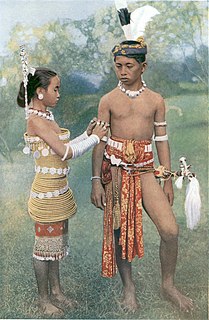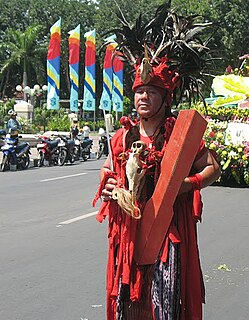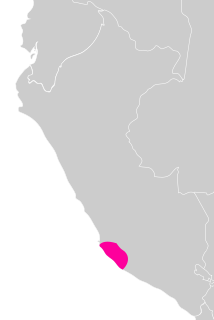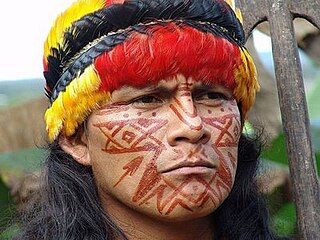 W
WHeadhunting is the practice of hunting a human and collecting the severed head after killing the victim, although sometimes more portable body parts are taken instead as trophies. Headhunting was practised in historic times in parts of Europe, East Asia, Oceania, Southeast Asia, South Asia, Mesoamerica, West and Central Africa.
 W
WAlfur, Alfurs, Alfuros, Alfures, Alifuru or Horaforas people is a broad term recorded at the time of the Portuguese seaborne empire to refer all the non-Muslim, non-Christian peoples living in inaccessible areas of the interior in the eastern portion of Maritime Southeast Asia.
 W
WThe Atayal, also known as the Tayal and the Tayan, are a Taiwanese indigenous people. The Atayal people number around 90,000, approximately 15.9% of Taiwan's total indigenous population, making them the third-largest indigenous group. The preferred endonym is "Tayal", although the Taiwanese government officially recognizes them as "Atayal".
 W
WThe Atoni people are an ethnic group on Timor, in Indonesian West Timor and the East Timorese enclave of Oecussi-Ambeno. They number around 844,030. Their language is Uab Meto.
 W
WBadu or Badu Island, pronounced ['ba:du:] in English, in Kala Lagaw Ya Badhu [bad̪u], is an island in the Torres Strait 60 kilometres (37 mi) north of Thursday Island, Queensland, Australia. Badu Island is also a locality in the Torres Strait Island Region, and Wakaid is the only town, located on the south-east coast. This island is one of the Torres Strait Islands. The language of Badu is Kala Lagaw Ya.
 W
WBisaya is an indigenous people from the northwest coast of East Malaysia on the island of Borneo. Their population is concentrated around Beaufort, Kuala Penyu, Menumbok, Sipitang, Labuan Federal Territory and in Limbang District, Sarawak. The Bisaya tribe has many similarities with the Dusun Tatana tribe, especially in terms of language. It is evident that some of their dialogical language conversations are almost identical if they have a dialogue with each other. Nowadays the Bisaya living in Sabah are Muslim, while the Bisaya living in Sarawak are mostly Christian. In Brunei, they are referred as Dusun, Jati Dusun and Bisaya. The Bisaya is closely related, linguistically, with the Tatana Dusun of Kuala Penyu, Sabah. The Bisaya people are also regarded as a relatives of the Dayak people whereas Bisaya was not brought into Borneo instead they are aboriginal of the land.
 W
WThe Bugkalot are a tribe inhabiting the southern Sierra Madre and Caraballo Mountains, on the east side of Luzon in the Philippines, primarily in the provinces of Nueva Vizcaya and Nueva Ecija and along the mountain border between the provinces of Quirino and Aurora. They are also commonly referred to as "Ilongot", especially in older studies, but nowadays, the endonym Bugkalot is preferred in modern ethnic research. They were formerly headhunters.
 W
WThe Chin people are a Southeast Asian Zo people native to Chin State of Myanmar. The Chin are one of the founding groups of the Union of Burma. The Chin speak a variety of related languages, share elements of cultures and traditions. According to BBC News, "The Chin people... are one of the most persecuted minority groups in Burma." These people predominantly live in the Chin State, Bago Division, Ayeyarwady Division, Magwe Division, Rakhine State and Sagaing Region of Myanmar, but are also spread throughout Burma, Bangladesh and India. In the 2014 Burmese ethnic census, the Chin ethnicity was again dismissed by the people of the Chin State.
 W
WThe Dayak or Dyak or Dayuh are one of the native groups of Borneo. It is a loose term for over 200 riverine and hill-dwelling ethnic groups, located principally in the central and southern interior of Borneo, each with its own dialect, customs, laws, territory, and culture, although common distinguishing traits are readily identifiable. Dayak languages are categorised as part of the Austronesian languages. The Dayak were animist in belief; however, since the 19th century there has been mass conversion to Christianity as well as Islam due to the spreading of foreign religions.
 W
WDusun is the collective name of a tribe or ethnic and linguistic group in the Malaysian state of Sabah of North Borneo. Collectively, they form the largest ethnic group in Sabah. Dusun has been recognized as among the indigenous community of Borneo, with documented heritage by the United Nations Educational, Scientific and Cultural Organization (UNESCO) since 2004.
 W
WThe Garos are a Tibeto-Burman ethnic group from the Indian subcontinent, notably found in the Indian states of Meghalaya, Assam, Tripura, Nagaland, and some neighboring areas of Bangladesh, notably Madhupur, Mymensingh, Netrokona, Jamalpur, Sherpur and Sylhet, Rangamati who call themselves A·chik Mande or simply A·chik or Mande - the name "Garo" being given to them and used by non-Garos. Historically, Garo name was used for wide range of people in southern bank of Brahmaputra but today, Garo means Hill tribes who call themselves A'chik Mande. They are the second-largest tribe in Meghalaya after the Khasi and comprise about a third of the local population. The Garos are one of the few remaining matrilineal societies in the world.
 W
WThe Ibans or Sea Dayaks are a branch of the Dayak peoples on the island of Borneo in South East Asia. Dayak is a title given by the westerners to the local people of Borneo island. It is believed that the term "Iban" was originally an exonym used by the Kayans, who – when they initially came into contact with them – referred to the Sea Dayaks in the upper Rajang river region as the "Hivan".
 W
WThe indigenous peoples of the Cordillera Mountain Range of northern Luzon, Philippines are often referred to using the exonym Igorot people, or more recently, as the Cordilleran peoples. There are nine main ethnolinguistic groups whose domains are in the Cordillera Mountain Range, altogether numbering about 1.5 million people in the early 21st century.
 W
WThe Jivaroan peoples are the indigenous peoples in the headwaters of the Marañon River and its tributaries, in northern Peru and eastern Ecuador. They speak one of the language family of the same name.
 W
WBeing an indigenous tribe in Borneo, the Kayan people are similar to their neighbours, the Kenyah tribe, with which they are grouped together with the Bahau people under the Apo Kayan people group. The Kayan people are categorised as a part of the Dayak people. They are distinct from, and not to be confused with, the Kayan people of Myanmar.
 W
WThe Kelabit are an indigenous Dayak people of the Sarawak/North Kalimantan highlands of Borneo with a minority in the neighbouring state of Brunei. They have close ties to the Lun Bawang. The elevation there is slightly over 1,200 meters. In the past, because there were few roads and because the area was largely inaccessible by river because of rapids, the highlands and the Kelabit were relatively untouched by modern western influences. Now, however, there is a relatively permanent road route on which it is possible to reach Bario by car from Miri. The road is marked but driving without a local guide is not advisable, as it takes over 11 hours of driving to reach Bario from Miri through many logging trail junctions and river crossings.
 W
WThe Konyaks are one of the major Naga ethnic groups. In Nagaland, they inhabit the Mon District—also known as 'The Land of The Anghs'. The Anghs/Wangs are their traditional chiefs whom they hold in high esteem. Facial tattoos were earned for taking an enemy's head.
 W
WGuite is the progenitor clan of Zomi people He is also said to be the Older Brother of Thadou progenitor of the Thadou people. Mostly the Guite clan speak Paite language. Most of them are known as Zomi and few also as Paite/Zomi in India and as Zogam in Myanmar (Burma). Depending on local pronunciation, the clan was also called differently such as Nguite, Vuite, and was also recorded even as Gwete, Gwite, Nwite. In accord with the claim of their solar origin, the Guite clan has been called nampi, meaning noble or major or even dominant people, of the region in local dialect in the past.
 W
WThe Kuki people are an ethnic group native to the Mizo Hills, a mountainous region in the southeastern part of Mizoram in India. The Kuki constitute one of several hill tribes within India, Bangladesh, and Myanmar. In northeast India, they are present in all states except Arunachal Pradesh.
 W
WLanga Langa Lagoon or Akwalaafu is a natural lagoon on the West coast of Malaita near the provincial capital Auki within the Solomon Islands. The lagoon is 21 km in length and just under 1 km wide. The "lagoon people" or "salt water people" live on small artificial islands built up on sand bars over time where they were forced to flee from the headhunters of mainland Malaita.
 W
WThe Lun Bawang is an ethnic group found in Central Northern Borneo. They are indigenous to the southwest of Sabah, and the northern region of Sarawak, highlands of North Kalimantan, Brunei.
 W
WThe Minahasans are an ethnic group native to the North Sulawesi province of Indonesia, formerly known as North Celebes. The Minahasa people sometimes refer to themselves as Manado people. Although the Minahasan pre-Christian creation myth entails some form of ethnic unification, before the nineteenth century the Minahasa region was in no way unified. Instead, a number of politically independent groups (walak) existed together, often in a permanent state of war.
 W
WThe Mizo people are an ethnic group native to northeastern India. This term covers several ethnic peoples who speak various Mizo-Kuki-Chin languages.
 W
WMurray Island in the Torres Strait Island Region, Queensland, Australia. The island is part of the Murray Island Group in the Torres Strait. The town is on the island's northwest coast and within the locality of Mer Island. The island is of volcanic origin, the most easterly inhabited island of the Torres Strait Islands archipelago, just north of the Great Barrier Reef. The name Meer/Mer/Maer comes from the native Meriam language. In the 2016 census, Murray Island had a population of 453.
 W
WThe Murut are an indigenous ethnic group, comprising 29 sub-ethnic groups inhabiting the northern inland regions of Borneo. The Murutic languages are a family of half a dozen closely related Austronesian languages. The Murut can be found mainly in Sabah, Malaysia including in Sarawak, Malaysia, Brunei, and Kalimantan, Indonesia.
 W
WThe Nazca culture was the archaeological culture that flourished from c. 100 BC to 800 AD beside the arid, southern coast of Peru in the river valleys of the Rio Grande de Nazca drainage and the Ica Valley. Strongly influenced by the preceding Paracas culture, which was known for extremely complex textiles, the Nazca produced an array of crafts and technologies such as ceramics, textiles, and geoglyphs.
 W
WNew Georgia, with an area of 2,037 km2 (786 sq mi), is the largest of the islands in Western Province, Solomon Islands, and the 200th-largest island in the world.
 W
WNias is an island located off the western coast of Sumatra, Indonesia. Nias is also the name of the archipelago of which the island is the centre, but also includes the Batu Islands to the south-east and the small Hinako Islands to the west. Nias Island covers an area of 5,625.0 km2 (2,171.8 sq mi). It is mostly a lowland area rising to around 800 m (2,600 ft) above sea level. There were 756,338 inhabitants on the island at the 2010 Census; at the 2015 Census this had risen to 798,506 and the 2020 Census resulted in a total of 880,550.
 W
WThe Nocte are an ethnic Naga tribe primarily living in Arunachal. They number about 111,679, mainly found in the Patkai hills of Tirap district of Arunachal Pradesh, India. Ethnically related to the Konyak Naga, their origins can be traced back to the Hukong Valley in Myanmar, where they migrated from between the 1670 and 1700.
 W
WThe Nuaulu, Naulu or Nunuhai are a tribe located in Seram, Maluku, Indonesia.
 W
WThe Paiwan are an indigenous people of Taiwan. They speak the Paiwan language. In 2014, the Paiwan numbered 96,334. This was approximately 17.8% of Taiwan's total indigenous population, making them the second-largest indigenous group.
 W
WThe Sakizaya are Taiwanese indigenous peoples with a population of approximately 1,000. They primarily live in Hualien, where their culture is centered.
 W
WThe Sambas riots were an outbreak of inter-ethnic violence in Indonesia, in 1999. The conflict started in the regency of Sambas, West Kalimantan Province. The conflict involved Malay allying with the indigenous Dayak people in order to massacre the migrant Madurese from the island of Madura.
 W
WThe Seediq are a Taiwanese indigenous people who live primarily in Nantou County and Hualien County. Their language is also known as Seediq.
 W
WThe Shuar are an Indigenous people of Ecuador and Peru. They are members of the Jivaroan peoples, who are Amazonian tribes living at the headwaters of the Marañón River.
 W
WTaiwanese indigenous peoples, Formosan people, Austronesian Taiwanese, Yuanzhumin or Gāoshān people, are the indigenous peoples of Taiwan, who number about 569,000 or 2.38% of the island's population. This total is increased to more than 800,000 people if the indigenous peoples of the plains in Taiwan are included, pending future official recognition. Recent research suggests their ancestors may have been living on Taiwan for approximately 6,500 years. A wide body of evidence suggests Taiwan's indigenous people maintained regular trade networks with regional cultures before major Han (Chinese) immigration from continental Asia began in the 17th century.
 W
WThe Torajans are an ethnic group indigenous to a mountainous region of South Sulawesi, Indonesia. Their population is approximately 1,100,000, of whom 450,000 live in the regency of Tana Toraja. Most of the population is Christian, and others are Muslim or have local animist beliefs known as aluk. The Indonesian government has recognised this animistic belief as Aluk To Dolo.
 W
WThe Wa people are a Southeast Asian ethnic group that lives mainly in Northern Myanmar, in the northern part of Shan State and the eastern part of Kachin State, near and along Myanmar's border with China, as well as in China's Yunnan Province.
 W
WThe Wancho are indigenous people inhabiting the Patkai hills of Longding district in the Indian state of Arunachal Pradesh. Culturally Naga, they are ethnically related to the Nocte of Arunachal Pradesh and Konyak of Nagaland. The Wancho language belongs to the Tibeto-Burman family under Northern Naga languages
 W
WThe Zou people are an indigenous community living along the frontier of India and Burma, they are a sub-group of the Zo people (Mizo-Kuki-Chin). In India, they live with and are similar in language and habits to the Paite and the Simte peoples. In Burma, the Zou are counted among the Chin people.They are a hill people, "Zou" may plainly means "Hills" denoting the Zous are "people of the hills" or "of the hills", and "Zou" has also a different meaning in Zou language that is "complete" or another word for it is "finish". But, the Zou people believed that they incepted the name 'Zou' from their forefather 'Zou' or 'Zo', believed to be the progenitor of the broad Chin-Kuki-Mizo people. The Zous can be found in different parts of India and also of the world.